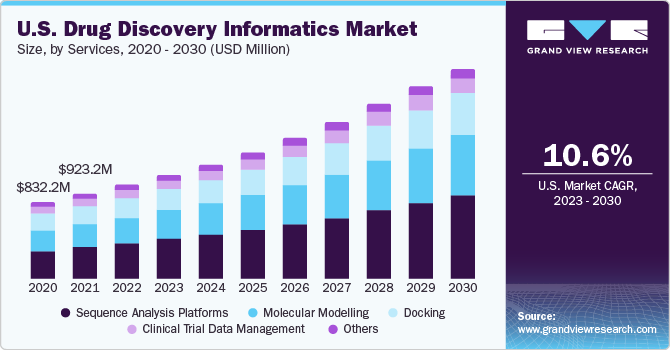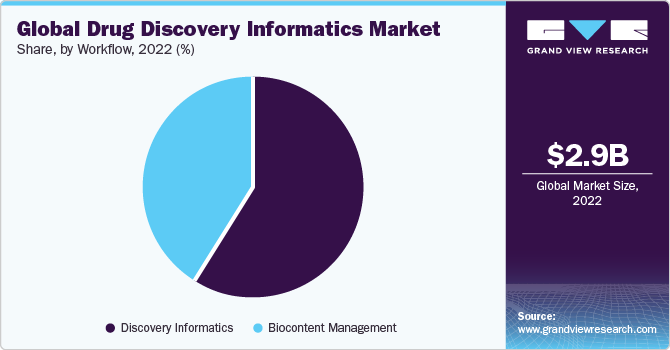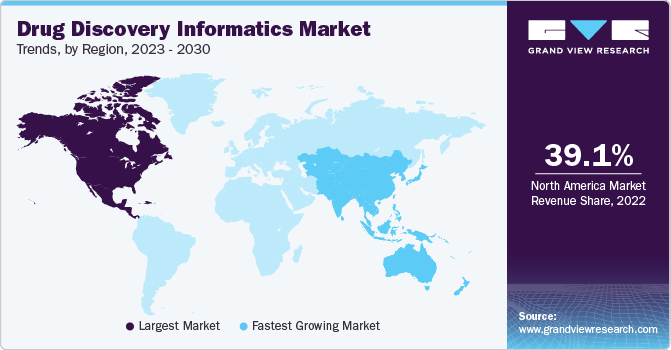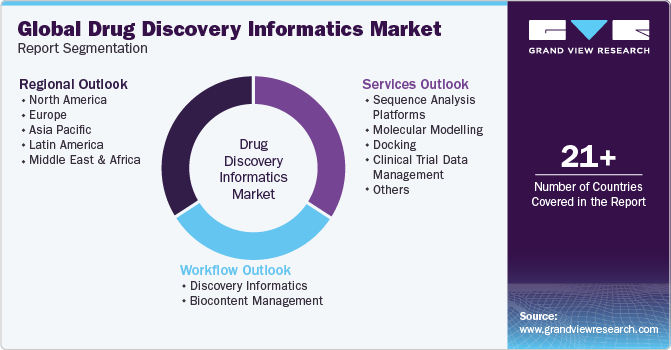- Home
- »
- Pharmaceuticals
- »
-
Drug Discovery Informatics Market Size & Share Report 2030GVR Report cover
![Drug Discovery Informatics Market Size, Share & Trends Report]()
Drug Discovery Informatics Market Size, Share & Trends Analysis Report By Workflow (Discovery Informatics, Biocontent Management), By Services (Sequence Analysis Platform), By Region, And Segment Forecasts, 2023 - 2030
- Report ID: 978-1-68038-749-0
- Number of Report Pages: 120
- Format: PDF, Horizon Databook
- Historical Range: 2018 - 2021
- Forecast Period: 2023 - 2030
- Industry: Healthcare
Drug Discovery Informatics Market Trends
The global drug discovery informatics market size was valued at USD 2.96 billion in 2022 and is anticipated to grow at a CAGR of 11.2% from 2023 to 2030. The market for drug discovery informatics is expected to experience significant growth in the coming years. This can be attributed to various factors, including advancements in high-performance computing and web services, increased adoption of in-silico modeling tools, the growing volume of data in drug discovery, and rising demand for innovative drug molecules. Introducing advanced information technology solutions for drug discovery is expected to intensify industry competition. For instance, in January 2021, Certara, Inc. unveiled the latest version of their Simcyp Physiologically-based Pharmacokinetic (PBPK) Simulator platform. This new platform incorporates models that assess and analyze drug actions during pregnancy and lactation.

The market is poised for substantial growth in the coming years, driven by advancements in high-performance computing and web services, the increasing adoption of in-silico modeling tools, a growing volume of drug discovery data, and rising demand for innovative drug molecules. This growth is further fueled by the launch of advanced information technology solutions in drug discovery, leading to intensified competition among industry players. For example, Certara, Inc. introduced the Simcyp Physiologically-based Pharmacokinetic (PBPK) Simulator version 20, which provides new models for assessing drug action during pregnancy and lactation, aiding in critical decisions related to optimizing medicine safety and efficacy profiles.
Furthermore, there is a growing trend among companies to adopt informatics solutions to streamline and shorten the drug discovery timeline. Curve Therapeutics Ltd. implemented the CDD Vault platform to manage its genetically encoded Microcycle platform. This hosted platform offers secure data management and seamless real-time data sharing, facilitating collaborative discoveries across the pharmaceutical, biotechnology, and academic sectors.
The ongoing global efforts in COVID-19 drug discovery have also contributed to the market's growth. Scientists have utilized in silico tools and virtual screening techniques to identify potential drug candidates by targeting viral proteins and human ACE2 receptors. Moreover, companies are developing web services and solutions specifically tailored for various stages of drug development related to COVID-19. For instance, the IBM visual molecular explorer platform has been utilized to explore a curated set of molecules targeting the SARS-CoV-2 virus, allowing for the sharing of AI-generated artifacts and supporting the design of optimal medicines.
Workflow Insights
The discovery informatics segment accounted for the largest revenue share of around 60% in 2022, with a major focus on developing precision medicines. Precision medicine revolves around providing personalized medical care tailored to an individual's genetic and molecular profile. Companies such as PerkinElmer, Inc. offer innovative solutions utilizing analytics to accelerate drug discovery.
Furthermore, in several developing countries, governments are actively encouraging the adoption of bioinformatics to expedite drug discovery processes. For example, the Indian government launched the Drug Discovery Hackathon (DDH) in July 2020. This initiative aimed to promote the identification, validation, and design of an effective molecule against the COVID-19 virus using drug discovery informatics tools. The DDH served as a training program to equip participants with the necessary skills for lead molecule synthesis.

The Drug Discovery Hackathon (DDH), launched by the Indian government in July 2020, aimed to utilize drug discovery informatics tools to identify and design effective molecules against COVID-19. This initiative served as a comprehensive training program, equipping participants with the essential skills required for lead molecule synthesis in the fight against the pandemic.
The drug development workflow segment is projected to exhibit the highest compound annual growth rate (CAGR) of 10.9% from 2022 to 2030. This growth can be attributed to the increasing number of medicine candidates in the pipeline for pharmaceutical companies. Drug discovery informatics tools play a crucial role in clinical trial design, ensuring optimal trial performance and the greatest potential for improvement. The Discovery Informatics segment is expected to grow at the fastest rate of 10.9% during the forecast period.
Services Insights
The sequence analysis platforms dominated the market in terms of revenue in 2022 and is also expected to maintain its leading position and exhibit the fastest compound annual growth rate (CAGR) of 11.7% over the forecast period. Bioinformatic solutions are widely employed for the development of primary and secondary databases of nucleic acids, proteins, and other biomolecule sequences. Informatics software enables the mining and warehousing of genome sequencing data to identify genes and targeted proteins, thereby facilitating the development of potential drugs.
Different databases and analysis techniques are employed in basic drug discovery research, with sequence analysis tools like CLUSTALW, BLAST, and FASTA playing a crucial role. The launch of new and advanced software in this field contributes to the growth of the segment. For example, Certara introduced version 19.6 of its scientific informatics platform, D360, in July 2019. This platform allows for the alignment, representation, and analysis of protein and peptide sequences, including the arrangement of sequences based on color-coded properties.
Informatics platforms also play a significant role in molecular modeling, which is increasingly popular in the drug discovery process. These tools enable the modeling and simulation of biological systems and small molecules, providing insights into their behavior at a molecular level. Additionally, they contribute to the cost-efficiency of hit discovery and hit-to-lead optimization, accelerating the drug development process.
Regional Insights
North America has emerged as the market leader with the highest revenue share 39.09% in 2022, pertaining to several factors, including the increasing investments in research and development (R&D) activities focused on drug discovery and the advancements in data mining and analytics technologies. These developments have significantly contributed to the expansion of the market by enabling more efficient and effective analysis of large volumes of data in the drug discovery process. By leveraging advanced informatics tools and techniques, researchers and pharmaceutical companies can extract valuable insights and make informed decisions, leading to accelerated drug discovery and development efforts. The growth of the drug discovery informatics market is further fueled by global efforts to accelerate COVID-19 drug discovery. Companies are developing various web services and solutions specifically tailored for different stages of COVID-19 drug development. For example, in June 2020, the IBM Visual Molecular Explorer platform analyzed a subset of molecules designed to target the coronavirus (SARS-CoV-2). The platform's open-source sharing of AI-generated artifacts facilitated early-stage optimization of potential medicines.

Moreover, companies in the industry are increasingly focusing on joint ventures and research collaborations, which are expected to contribute to the market's growth in the upcoming years. In December 2020, Atomwise, a leading player in AI-driven small-molecule drug discovery, announced its expanding portfolio through a joint venture with A2i Therapeutics and FutuRx companies. This collaboration encompasses research programs spanning various therapeutic areas, including oncology, immunology, infectious disease, neuroscience, and clotting disorders. Such research collaborations in drug discovery generate significant demand for drug discovery informatics, thereby driving the market's expansion.
Asia Pacific is expected to grow at the fastest CAGR of 11.9% during the forecast period. This is possible due to the rapid growth of pharmaceutical and biopharmaceutical industries and the expanding number of CROs in the region. China and India are the major countries offering promising growth opportunities over the forecast period.
Key Companies & Market Share Insights
To speed up drug development, key players in the industry are actively collaborating with other companies, research institutes, and clinical research organizations. These partnerships aim to enhance efficiency and accelerate the delivery of valuable data. An example of such collaboration occurred in March 2020 when Charles River Laboratories International, Inc. partnered with Deciphex. The collaboration involved utilizing Deciphex's Patholytix Preclinical platform, designed to maximize pathologists' productivity and facilitate faster data delivery to clients. By leveraging this advanced platform, the partnership sought to optimize the workflow in preclinical studies, ultimately contributing to more efficient drug development processes.
Key Drug Discovery Informatics Companies:
- Certara
- Boehringer Ingelheim International GmbH
- Infosys Ltd.
- Charles River Laboratories
- Collaborative Drug Discovery, Inc.
- Eurofins DiscoverX Products
- Jubliant Biosys
- Selvita
- Novo Informatics Pvt. Ltd.
- ChemAxon Ltd.
- Albany Molecular Research Inc.
- Oracle
- Accenture
- Agilent Technologies, Inc.
- Illumina, Inc.
Drug Discovery Informatics Market Report Scope
Report Attribute
Details
Market size value in 2023
USD 3.26 billion
Revenue forecast in 2030
USD 6.86 billion
Growth rate
CAGR of 11.2% from 2023 to 2030
Base year for estimation
2022
Historical data
2018 - 2021
Forecast period
2023 - 2030
Report updated
December 2023
Quantitative units
Revenue in USD billion and CAGR from 2023 to 2030
Report coverage
Revenue forecast, company ranking, competitive landscape, growth factors, and trends
Segments covered
Workflow, services, region
Regional scope
North America; Europe; Asia Pacific; Latin America; MEA
Country scope
U.S.; Canada; UK; Germany; France; Italy; Spain; Denmark; Sweden; Norway; China; Japan; India; Australia; South Korea; Thailand; Brazil; Mexico; Argentina; Saudi Arabia; South Africa; UAE; Kuwait
Key companies profiled
Certara; Boehringer Ingelheim International GmbH; Infosys Ltd.; Charles River Laboratories; Collaborative Drug Discovery, Inc.; Eurofins DiscoverX Products; Jubilant Biosys; Selvita; Novo Informatics Pvt. Ltd.; ChemAxon Ltd.; Albany Molecular Research Inc.; Oracle; Accenture; Agilent Technologies, Inc.; Illumina, Inc.
Customization scope
Free report customization (equivalent up to 8 analyst’s working days) with purchase. Addition or alteration to country, regional & segment scope
Pricing and purchase options
Avail customized purchase options to meet your exact research needs. Explore purchase options
Global Drug Discovery Informatics Market Report Segmentation
This report forecasts revenue growth at global, regional, and country levels and provides an analysis of the latest industry trends in each of the sub-segments from 2018 to 2030. For the purpose of this study, Grand View Research has segmented the global drug discovery informatics market on the basis of workflow, services, and region:

-
Workflow Outlook (Revenue, USD Billion, 2018 - 2030)
-
Discovery Informatics
-
Biocontent Management
-
-
Services Outlook (Revenue, USD Billion, 2018 - 2030)
-
Sequence Analysis Platforms
-
Molecular Modelling
-
Docking
-
Clinical Trial Data Management
-
Others
-
-
Regional Outlook (Revenue, USD Billion, 2018 - 2030)
-
North America
-
U.S.
-
Canada
-
-
Europe
-
UK
-
Germany
-
France
-
Italy
-
Spain
-
Sweden
-
Norway
-
Denmark
-
-
Asia Pacific
-
China
-
Japan
-
India
-
Australia
-
Thailand
-
South Korea
-
-
Latin America
-
Brazil
-
Mexico
-
Argentina
-
-
Middle East and Africa
-
Saudi Arabia
-
South Africa
-
UAE
-
Kuwait
-
-
Frequently Asked Questions About This Report
b. The global drug discovery informatics market size was estimated at USD 2.96 billion in 2022 and is expected to reach USD 3.26 billion in 2023.
b. The global drug discovery informatics market is expected to grow at a compound annual growth rate of 11.2% from 2023 to 2030 to reach USD 6.86 billion by 2030.
b. North America dominated the drug discovery informatics market with a share of 39.09% in 2022. This is attributable to higher incidence rates of different infectious diseases & oncology diseases and simultaneous developments of next-generation sequencing & chemical laboratories in the region.
b. Some key players operating in the drug discovery informatics market include Albany Molecular Research Inc.; Certara; Boehringer Ingelheim GmBh; Charles River Laboratories; Infosys; GVK Biosciences; Collaborative Drug Discovery Inc.; DiscoverX; ChemAxon; Jubilant Biosys; Novo Informatics; and Selvita.
b. Key factors that are driving the drug discovery informatics market growth include Increasing adoption of in-silico modeling tools, advancements in high-performance computing and web services, the growing volume of drug discovery data, and growth in demand for novel drug moieties.
Share this report with your colleague or friend.
![gvr icn]()
NEED A CUSTOM REPORT?
We can customize every report - free of charge - including purchasing stand-alone sections or country-level reports, as well as offer affordable discounts for start-ups & universities. Contact us now
![Certified Icon]()
We are GDPR and CCPA compliant! Your transaction & personal information is safe and secure. For more details, please read our privacy policy.
We are committed towards customer satisfaction, and quality service.
"The quality of research they have done for us has been excellent."





